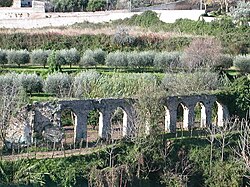You can help expand this article with text translated from the corresponding article in Italian. (January 2022)Click [show] for important translation instructions.
|
Eboli | |
|---|---|
| Comune di Eboli | |
 | |
| Coordinates: 40°36′58.53″N15°03′17.69″E / 40.6162583°N 15.0549139°E | |
| Country | Italy |
| Region | Campania |
| Province | Salerno (SA) |
| Frazioni | Campolongo, Cioffi, Corno d'oro, Fiocche, Santa Cecilia, Taverna Nova |
| Government | |
| • Mayor | Mario Conte (Article One) |
| Area | |
• Total | 138.7 km2 (53.6 sq mi) |
| Elevation | 145 m (476 ft) |
| Population (31 May 2022) [2] | |
• Total | 37,488 |
| • Density | 270.3/km2 (700.0/sq mi) |
| Demonym | Ebolitani |
| Time zone | UTC+1 (CET) |
| • Summer (DST) | UTC+2 (CEST) |
| Postal code | 84020, 82025 |
| Dialing code | 0828 |
| Patron saint | Saint Vitus |
| Saint day | 15 June |
| Website | Official website |
Eboli (Ebolitano: Jevule) is a town and comune of Campania, southern Italy, in the province of Salerno. [3]
Contents
- History
- Geography
- Main sights
- Culture
- Twin Town
- In media
- Notable people
- See also
- References
- External links
Eboli, an agricultural centre, is renowned for its olive oil and dairy products, most notably the famous buffalo mozzarella from the area.



